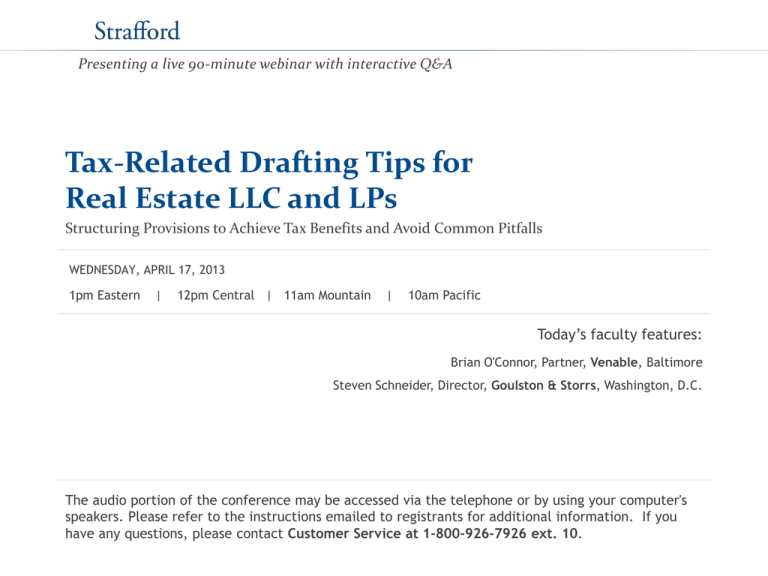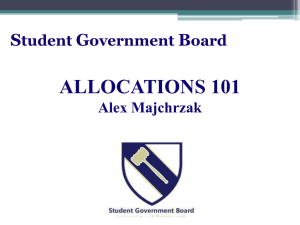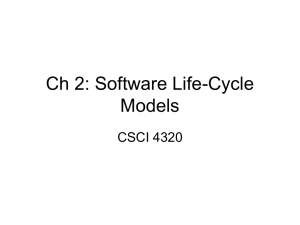Tax-Related Drafting Tips for Real Estate LLC
advertisement

Presenting a live 90-minute webinar with interactive Q&A Tax-Related Drafting Tips for Real Estate LLC and LPs Structuring Provisions to Achieve Tax Benefits and Avoid Common Pitfalls WEDNESDAY, APRIL 17, 2013 1pm Eastern | 12pm Central | 11am Mountain | 10am Pacific Today’s faculty features: Brian O'Connor, Partner, Venable, Baltimore Steven Schneider, Director, Goulston & Storrs, Washington, D.C. The audio portion of the conference may be accessed via the telephone or by using your computer's speakers. Please refer to the instructions emailed to registrants for additional information. If you have any questions, please contact Customer Service at 1-800-926-7926 ext. 10. Tips for Optimal Quality Sound Quality If you are listening via your computer speakers, please note that the quality of your sound will vary depending on the speed and quality of your internet connection. If the sound quality is not satisfactory and you are listening via your computer speakers, you may listen via the phone: dial 1-866-871-8924 and enter your PIN when prompted. Otherwise, please send us a chat or e-mail sound@straffordpub.com immediately so we can address the problem. If you dialed in and have any difficulties during the call, press *0 for assistance. Viewing Quality To maximize your screen, press the F11 key on your keyboard. To exit full screen, press the F11 key again. Continuing Education Credits FOR LIVE EVENT ONLY For CLE purposes, please let us know how many people are listening at your location by completing each of the following steps: • In the chat box, type (1) your company name and (2) the number of attendees at your location • Click the SEND button beside the box Program Materials If you have not printed the conference materials for this program, please complete the following steps: • Click on the + sign next to “Conference Materials” in the middle of the lefthand column on your screen. • Click on the tab labeled “Handouts” that appears, and there you will see a PDF of the slides for today's program. • Double click on the PDF and a separate page will open. • Print the slides by clicking on the printer icon. Tax-Related Drafting Tips for Real Estate LLC and LPs Strafford April 17, 2013 Brian J. O’Connor Steven R. Schneider Introduction Understand the partners and their tax characteristics. Learn the general economics/business deal (e.g., capital commitments, preferred versus common interests, compensatory interests, distributions (including tax distributions), special partners, etc.). Create an everyday working relationship, therefore needs to be cooperative in addition to adversarial. 6 Review the Cash Flow and Allocations Terms of preferred interests. Operating versus liquidating distributions. Other: Tax distributions. Capital calls and partner loans. 7 Types of Preferred Interests Distribution-based preferred. Liquidate with cash waterfall. Preferred return typically paid even if there is no net profit. Section 704(b) allocation-based preferred. Liquidate with section 704(b) capital accounts. Guaranteed payments. Not part of profit and loss allocation section. Separate section generally referencing section 707(c) and providing specific interest like return to preferred partner. 8 Tax Distributions Many agreements contain minimum distributions to a partner to ensure that it has sufficient funds to satisfy taxes relating to its share of partnership income. Typically documented as an advance on the partner’s rights under the more general distribution provisions. Sometimes distributions are treated as a loan to the partner. Generally equal to share of net income multiplied by maximum applicable rate for type of income. Variables: Actual versus assumed rates, partners subject to different tax rates, losses followed by profits, quarterly versus annual distributions. 9 Liquidation Alternatives This section may be the key to learning whether the agreement intends to follow the regulatory book allocation safe harbors. An agreement likely follows safe harbors if, after paying creditors and setting up reserves, the agreement distributes the remaining proceeds according to the partners’ positive capital accounts. If the agreement instead liquidates with a cash waterfall, then the agreement must rely on a more limited tax safe harbor to get comfort that the IRS will respect the income and loss allocations (the partners would receive the same economic distributions as had they liquidated in accordance with each partner’s capital account). This would occur, for example, in a simple 50-50 partnership where all capital is contributed equally and all profits, losses, and distributions are shared equally. 10 Elections and Audits Elections: Agreement should address how partnership-level tax elections are made. The two main elections unique to partnerships relate to section 754 inside basis adjustments and section 704(c) allocations of built-in gains or losses among the partners. Audits: Tax Matters Partner (TMP) generally represents the partnership before the IRS and in federal civil tax litigation and is required to keep the other partners informed. Generally, the TMP must be a manager and member. Although the identity and authority of the TMP may sound boring, it is often a critical question when later controversy arises and the details are often overlooked in the drafting process. 11 Special Partners REITs Tax-Exempts Foreign Partners 12 REIT Partners Where one of the members is a REIT, it will seek to impose the following types of restrictions on the joint venture’s operations in order to ensure compliance with the REIT requirements: Real estate asset holding and income limitations; No prohibited transactions (e.g., condo sales); Limitations on loans (mezz debt or secured by real property); Limitations on leases (related party and personal property restrictions); and Arm’s-length transactions with REIT owners. 13 Tax-Exempt Partners Tax-exempt entities are generally subject to the unrelated business income tax for investment returns funded with “acquisition debt.” However, there is a Real Estate Financing Exception for “qualified organizations” that use specific types of debt to acquire or improve real property. To meet the Real Estate Financing Exception, qualified organizations who invest through a partnership must meet the Fractions Rule. To be Fractions Rule compliant, partnership allocations must satisfy the following two requirements on actual and prospective basis: Safe harbor allocations: The most significant economic factor in satisfying these rules is that the partnership liquidate with positive capital accounts in lieu of a cash waterfall. Disproportionate allocation rule: A qualified organization’s share of overall income for any year cannot exceed its lowest share of overall loss for any year. 14 Foreign Partners Partnerships are required to withhold taxes on a foreign investor’s share of real estate income because special “FIRPTA” rules treat the partner’s income from real estate as subject to U.S. taxation even if the income is not otherwise subject to U.S. tax. A partnership agreement typically treats this withholding as a partner distribution or loan. Certain partners may be subject to reduced withholding, but the partnership should require the partner to provide specific documentation to the partnership to receive the reduced rate. 15 Example 1: Capital Account Basics Section 704(b) 16 Property contribution; income allocation; distribution Facts: A contributes Building with $100 gross fair market value, subject to $30 of debt. In year one the partnership allocates $10 of section 704(b) book income to A and distributes $4 of cash to A. Effect on Capital Account Increase by net FMV of +$70 property contributed Increase by income +$10 allocation Decrease by -$4 distributions Ending Capital Account $70 $80 $76 17 Tax Allocations – sections 704(b) and 704(c) How taxable income and loss are shared among the partners. Most of the allocation language relates to the economic/book allocations and in general taxable income will follow these book allocations. If a partner contributed an asset with built-in appreciation or depreciation, special rules require that such built-in tax gain or loss is allocated back to the contributing partner. 18 Tax Allocations – section 704(b) Partnership agreements typically break the book allocations down into two sections. The primary allocation section describes the general business deal, such as allocating profits in accordance with relative capital or profit percentages (i.e., “Percentage Interests”). The second section (regulatory allocations) overrides the first section and is designed to comply with the book income tax regulatory safe harbors. 19 Tax Allocations – section 704(b) The tax allocations will not be respected if the agreement liquidates with a waterfall and the partners’ economic rights under the waterfall are different from their rights based on their capital accounts. The taxable income or loss will be re-allocated so that the capital accounts and the waterfall rights are consistent. Example - tax allocations send all $100 of section 704(b) income to Partner A and none to Partner B. A’s capital account increases by all $100 and B’s capital account remains constant. If the waterfall provides that the cash corresponding to that profit is shared $50 each by A and B, then the IRS will not respect the tax allocation and will reallocate $50 of income to B. To avoid inconsistencies between tax allocations and the partners’ rights under the waterfall, many partnership agreements simply use a Target allocation (allocates book income or loss among the partners using a formula that causes the partners’ capital accounts to equal the amounts the partners would receive under the waterfall). 20 Tax Allocations – section 704(c) “Section 704(c)” generally requires the partnership to allocate built-in gain or loss back to the contributing partner. Partnership agreements typically include only a single paragraph to cover these allocations and often simply repeat the general statutory requirement that tax allocations take into account a partner’s potential built-in tax gain or loss on contributed property. For many partnerships (including many real estate partnerships), this provision is highly negotiated and includes much more detail relating to which of several alternative methods is chosen to allocate non-economic taxable income or loss. 21 Example 2: 704(c) Basics Facts: Partner A contributes property with a tax basis of $20 and a value of $100 and the partnership sells the property for $110. 704(c) effect: The partnership must allocate the first $80 of tax gain to Partner A because that represents the inherent built-in gain. A B 20 V 100 property Partnership later sells property for $110 22 Built-in Gain/Loss Boilerplate Section 704(c) Allocations. In accordance with Section 704(c) of the Code and the Regulations thereunder, income, gain, loss and deduction with respect to any property contributed to the capital of the Partnership shall, solely for tax purposes, be allocated among the Partners under any reasonable method selected by the General Partner so as to take account of any variation between the adjusted basis of such property to the Partnership for federal income tax purposes and its initial Book Value. If the Book Value of any Partnership asset is adjusted pursuant to clause (c) or (d) of the definition thereof, subsequent allocations of income, gain, loss and deduction with respect to such asset shall take account of any variation between the adjusted basis of such asset for federal income tax purposes and its Book Value in the same manner as under Section 704(c) of the Code and the Regulations thereunder. Any elections or other decisions relating to such allocations shall be made by the General Partner in a manner that reasonably reflects the purpose and intention of this Agreement. Allocations pursuant to this section are solely for purposes of federal, state and local taxes and shall not affect, or in any way be taken into account in computing, any Partner’s Capital Account or share of Profits, Losses, other items or distributions pursuant to any provision of this Agreement. 23 Example 3: Partnership Nonrecourse Deductions A and B each contribute $100 to a 50-50 partnership and have no obligation to restore negative capital accounts. The partnership borrows $800 from an unrelated lender on a nonrecourse basis using an interest-only loan and buys Building for $1,000. The partnership depreciates Building by $100 a year. After the third year, the partnership has depreciated the initial $1,000 of section 704(b) basis in Building down to $700. 24 Computation of Minimum Gain Adjustment Purchase date Section 704(b) Nonrecourse Value debt Minimum gain $1,000 $800 $0 Year 1 depreciation ($100) $900 $800 $0 Year 2 depreciation ($100) $800 $800 $0 Year 3 depreciation ($100) $700 $800 $100 25 Capital Accounts, Minimum Gain, and Adjusted Capital Accounts A capital A minimum gain A’s Adjusted Capital Account B capital B minimum gain B’s Adjusted Capital Account Initial $100 $0 $100 $100 $0 $100 Year 1 $50 $0 $50 $50 $0 $50 Year 2 $0 $0 $0 $0 $0 $0 Year 3 ($50) $50 $0 ($50) $50 $0 26 What Does The Tax Boilerplate Actually Mean? A. Boilerplate Provisions – Capital Accounts Capital Accounts Depreciation Book Value Profit and loss 27 What Does the Tax Boilerplate Actually Mean? B. Boilerplate Provisions – Regulatory Allocations Loss Limitation Provision Adjusted Capital Account Deficit Gross Income Allocation Nonrecourse Debt Definitions Partnership Minimum Gain Chargeback Partner Minimum Gain Chargeback Partner Nonrecourse Deductions Curative/Subsequent Allocations 28 Target vs. Layer Cake Allocations Advanced Drafting 29 Basic Concepts Layer Cake Allocation Basic concept is to allocate § 704(b) book profit/loss first and use this allocation to determine the cash distributions. Targeted Allocations Basic concept is to allocate profit/loss so that, at the end of the taxable year, each partner’s capital account is equal to: • the amount that would be distributed to that partner in liquidation if all partnership assets were sold at their § 704(b) book value, less • the partner’s share of minimum gain. 30 Satisfaction of §704(b) Safe Harbors Both Layer Cake and Target Allocations COULD satisfy the safe harbors, if liquidated with capital accounts. The practical reality is Most Target allocations instead liquidate with the cash waterfall in which they target the income and do not satisfy the safe harbors. Most layer cake liquidate with positive §704(b) capital accounts and otherwise meet the safe harbors. Sometimes Target agreements also liquidate with capital accounts or Layer Cake agreements liquidate with cash waterfalls. 31 Example 1: Basic Target Allocations 32 Basic Facts LP and GP contribute $90 and $10, respectively. The distribution Waterfall Cash is paid first to return contributed capital plus a 10% annual preferred return Cash paid 80:20 to LP and GP, respectively. The partnership earns $20 of income in year one. 33 Waterfall LP GP Total Return of capital 90 10 100 Preferred return 9 1 10 Residual return 8 2 10 107 13 120 Total •For simplicity, the example shows the GP as only receiving a 20% residual profit sharing after the preferred return and no return on it’s capital at the residual return level. 34 Target Allocation A typical target allocation provision would allocate the $20 of year one earnings to “fill up” the LP and GP opening capital accounts ($90 and $10, respectively) to equal their Target rights under the Waterfall ($107 and $13, respectively). LP GP Total Beginning 90 10 100 Ending 107 13 120 Target 17 3 20 35 Economic Considerations Target Layer Cake Economic Certainty Yes, waterfall is certain Disproportionate sharing flexibility Can accommodate basic preferred Understandable by business side Yes Subject to §704(b) confusion, but better adjusts for disproportionate distribution and tax distributions Can provide more flexibility with preferred (e.g., gross losses to common, gross profits to preferred); allows different sharing per investment. Maybe, if you’re lucky 36 Economic Considerations Target Layer Cake Tax boilerplate/footfaults Not a problem Yes, lack of “Curative Allocation” could affect economics (e.g., P&L allocations 50:50 but capital disproportionate, losses followed by profits) Foreign hybrids Hybrid may not accommodate liquidation with capital accounts Yes 37 Tax Considerations Target Layer Cake Special allocations of depreciation No Yes Fractions rule §514(c)(9) Tax Uncertainty Tax certainty §1.704-2 excess nonrecourse deductions Not safe harbor Safe harbor 38 Basic Steps - Layer Cake Allocations Profit allocations Reverse prior losses Preferred return Residual sharing ratio Loss allocations Reverse prior profits (in reverse order) Relative contributed capital (adjusted capital accounts) Residual sharing ratio Adjust capital accounts for contributions, distributions, and allocations Liquidate with positive capital accounts 39 Basic Steps - Targeted Allocations Calculate Cash Waterfall Target Preferred return Preferred capital Common capital Residual sharing Profit/Loss allocations to bring adjusted capital account to equal Target Adjust the capital accounts for distributions Generally liquidate with cash waterfall, but can liquidate with positive capital accounts 40 3 Steps to Target Allocations Step 1 - Determine Partially Adjusted Capital Account (adjust beginning of year capital for current year contributions and distributions) Step 2 - Determine Target Capital Account (based on distribution waterfall at book value less minimum gain amounts) (a) Net value in partnership upon deemed liquidation: (b) Run value through distribution waterfall (c) Add back partner and partnership minimum gain Step 3 - Allocate Profit or Loss to bring Partially Adjusted Capital Accounts to Target Capital Account. 41 Example 2 – Net Income in Excess of Preference A B $100,000 $100,000 Beginning Balance Sheet Assets Cash: $200,000 Liabilities $0 Capital A: $100,000 B: $100,000 LLC Total $200,000 Total: $200,000 Year 1 Income = $50,000 10% preferred to A, residual A=40%, B=60% 42 Capital-Account Based Liquidation – Layer Cake Allocations (cont’d) Section 704(b) Income Allocations A Opening Capital B $100,000 $100,000 1. 10% pref to A. $ 10,000 $ 2. 40:60 A and B $ 16,000 $ 24,000 Total Income $ 26,000 $ 24,000 Ending Capital $126,000 $124,000 $50,000 Income 0 43 Capital-Account Based Liquidation – Targeted Allocations (cont’d) A Opening Capital Adjustments during year Partially adjusted cap acct B $100,000 0 $100,000 $100,000 0 $100,000 $250,000 Cash 1. 10% pref to A. 2. Return original capital 3. 40:60 A and B Ending Target Capital $ 10,000 $100,000 $ 16,000 $126,000 $ 0 $100,000 $ 24,000 $124,000 Income Allocation $ 26,000 $ 24,000 Determine Cash Waterfall 44 Example 3 – Net Income Less than Preference A B $100,000 $100,000 Beginning Balance Sheet Assets Cash: $200,000 Liabilities $0 Capital A: $100,000 B: $100,000 LLC Total $200,000 Total: $200,000 Year 1 Income = $8,000 10% preferred to A, residual A=40%, B=60% 45 Capital-Account Based Liquidation – Targeted Allocations (cont’d) A Opening Capital Adjustments during year Partially adjusted cap acct $100,000 0 $100,000 B $100,000 0 $100,000 Determine Cash Waterfall $208,000 Cash 1. 10% pref to A. 2. Return original capital 3. 40:60 A and B Ending Target Capital Target Income Allocation Net Income Allocation Shortfall (Gpmt?) $ 10,000 $ 99,000 $ $109,000 $ $ $ 9,000 8,000 1,000 $ 0 $ 99,000 $ $ 99,000 ($ $ ($ 1,000) 0 1,000) 46 Capital-Account Based Liquidation – Layer Cake Allocations (cont’d) Section 704(b) Income Allocations A Opening Capital B $100,000 $100,000 1. 10% pref to A. $ 8,000 $ 2. 40:60 A and B $ $ Total Income $ 8,000 $ Ending Capital $108,000 $100,000 $ 8,000 Income 0 0 47 Comparison of Examples 2 and 3 Ending Cash Received by A and B A B Example 2 Target/waterfall $126,000 $124,000 Layer Cake/cap acct $126,000 $124,000 Target/waterfall $109,000 $ 99,000 Layer Cake/cap acct $108,000 $100,000 Example 3 48 Final Thoughts Targets have become the baseline and trend is growing Some renewed sensitivity toward the limitations of target allocations No IRS guidance Impact on return preparers – pros and cons Less risk to tax allocations affecting economics 49 For further information Steven Schneider Brian J. O’Connor Goulston & Storrs, P.C. Washington, DC 202-721-1145 sschneider@goulstonstorrs.com www.taxlawroundup.com Venable LLP Baltimore, MD 410-244-7863 BJOconnor@Venable.com 50 Circular 230 Pursuant to IRS Circular 230, please be advised that, to the extent this communication contains any federal tax advice, it is not intended to be, was not written to be and cannot be used by any taxpayer for the purpose of (i) avoiding penalties under U.S. federal tax law or (ii) promoting, marketing or recommending to another taxpayer any transaction or matter addressed herein. 51 Q&A To ask a question from your touchtone phone, press *1. To exit the queue, press *1 again. You may also use the Chat function to ask questions, or email questions to propertylaw@straffordpub.com CLE CODE: TLXRRG After you complete a brief survey of this program, we'll send you a free $5 Starbucks Gift Card. Tell us how we did! Look for our 'Thank You' email (which you should receive shortly) for details and the survey link! Thanks. Please join us for our next conference, “Real Estate Mezzanine Intercreditor Agreements and Participation Agreements,” scheduled on Thursday, April 25, 2013 starting at 1pm EDT. Strafford Publications, Inc. 1-800-926-7926 www.straffordpub.com








